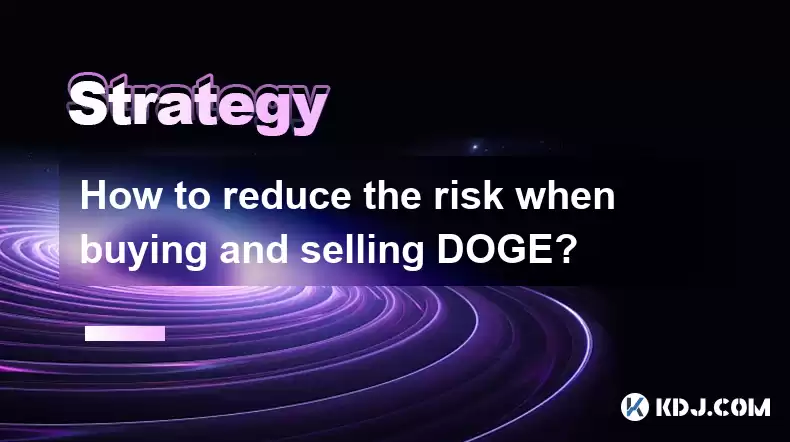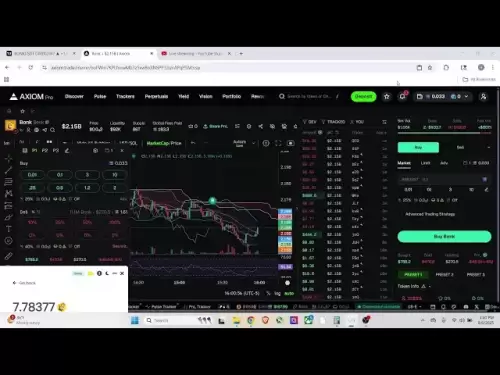-
 Bitcoin
Bitcoin $115000
1.10% -
 Ethereum
Ethereum $3719
2.93% -
 XRP
XRP $2.997
2.56% -
 Tether USDt
Tether USDt $1.000
0.02% -
 BNB
BNB $766.7
0.98% -
 Solana
Solana $169.6
3.97% -
 USDC
USDC $0.9999
0.00% -
 TRON
TRON $0.3391
1.82% -
 Dogecoin
Dogecoin $0.2060
3.53% -
 Cardano
Cardano $0.7429
2.91% -
 Hyperliquid
Hyperliquid $38.02
1.70% -
 Stellar
Stellar $0.4021
3.23% -
 Sui
Sui $3.515
3.31% -
 Bitcoin Cash
Bitcoin Cash $574.2
2.68% -
 Chainlink
Chainlink $16.85
3.10% -
 Hedera
Hedera $0.2461
1.54% -
 Ethena USDe
Ethena USDe $1.001
0.02% -
 Avalanche
Avalanche $22.28
1.26% -
 Litecoin
Litecoin $118.3
1.25% -
 UNUS SED LEO
UNUS SED LEO $8.923
-0.75% -
 Toncoin
Toncoin $3.255
2.35% -
 Shiba Inu
Shiba Inu $0.00001239
2.42% -
 Uniswap
Uniswap $9.834
3.77% -
 Polkadot
Polkadot $3.690
2.48% -
 Dai
Dai $1.000
0.02% -
 Monero
Monero $282.9
-3.30% -
 Bitget Token
Bitget Token $4.367
0.70% -
 Cronos
Cronos $0.1454
5.37% -
 Pepe
Pepe $0.00001055
3.60% -
 Ethena
Ethena $0.6156
8.72%
How to reduce the risk when buying and selling Doge?
To manage risk when trading Dogecoin, stay informed, use technical analysis, secure your trading environment, diversify your portfolio, and time your trades wisely.
Apr 20, 2025 at 12:49 pm

When engaging in the buying and selling of Dogecoin (DOGE), managing risk is crucial to protect your investments and maximize potential returns. This article will guide you through various strategies and practices that can help you reduce the risk associated with trading DOGE.
Understanding the Market and DOGE's Volatility
Dogecoin is known for its high volatility, which can lead to significant price swings in a short period. To reduce risk, it's essential to understand the market dynamics and DOGE's specific behavior.
- Stay Informed: Regularly check news and updates related to Dogecoin. Events like celebrity endorsements, new partnerships, or changes in the broader crypto market can significantly impact DOGE's price.
- Technical Analysis: Use technical analysis tools to study price charts and identify trends. Tools like moving averages, RSI, and Bollinger Bands can help predict potential price movements.
- Sentiment Analysis: Monitor social media and forums like Reddit and Twitter to gauge the sentiment around Dogecoin. Positive or negative sentiment can often precede price movements.
Setting Up a Secure Trading Environment
Before you start trading, ensure your trading environment is secure to minimize the risk of losing your funds due to hacks or phishing attacks.
- Choose a Reputable Exchange: Select a well-known and reputable cryptocurrency exchange that supports DOGE. Research the exchange's security measures, user reviews, and regulatory compliance.
- Enable Two-Factor Authentication (2FA): Activate 2FA on your exchange account to add an extra layer of security. This typically involves receiving a code on your mobile device that you must enter to access your account.
- Use Strong Passwords: Create a strong, unique password for your exchange account and wallet. Avoid using easily guessable passwords and change them regularly.
- Secure Your Wallet: Use a hardware wallet or a secure software wallet to store your DOGE. Hardware wallets offer the highest level of security as they keep your private keys offline.
Implementing Risk Management Strategies
Risk management is crucial when trading DOGE. Here are some strategies to help you manage your risk effectively.
- Diversify Your Portfolio: Don't put all your funds into DOGE. Diversify your investments across different cryptocurrencies and asset classes to spread the risk.
- Set Stop-Loss Orders: Use stop-loss orders to automatically sell your DOGE if the price drops to a certain level. This can help limit your losses if the market moves against you.
- Position Sizing: Only invest a small portion of your total capital in any single trade. A common rule of thumb is to risk no more than 1-2% of your trading capital on a single trade.
- Avoid Emotional Trading: Stick to your trading plan and avoid making impulsive decisions based on fear or greed. Emotional trading often leads to poor decision-making and increased risk.
Timing Your Trades
Timing your trades can significantly impact your success in trading DOGE. Here are some tips to help you time your trades more effectively.
- Monitor Market Trends: Pay attention to long-term and short-term market trends. Use technical analysis to identify potential entry and exit points.
- Trade During High Liquidity: DOGE tends to have higher liquidity during certain times of the day, typically when major markets like the US are active. Trading during these times can result in better price execution.
- Avoid Trading During High Volatility: While some traders thrive on volatility, it can also increase risk. Consider avoiding trading during periods of extreme market volatility, such as during major news events.
Utilizing Trading Tools and Resources
Leveraging the right tools and resources can help you make more informed trading decisions and reduce risk.
- Trading Bots: Consider using trading bots to automate your trading strategy. Bots can help you execute trades more quickly and consistently, reducing the risk of human error.
- Trading Journals: Keep a trading journal to track your trades, analyze your performance, and identify areas for improvement. This can help you refine your strategy and reduce risk over time.
- Educational Resources: Continuously educate yourself on cryptocurrency trading. Read books, take courses, and join trading communities to learn from experienced traders and stay updated on the latest trends and strategies.
FAQs
Q: Can I reduce risk by holding DOGE for the long term?
A: Holding DOGE for the long term can reduce the impact of short-term volatility, but it does not eliminate risk entirely. Long-term holding requires patience and a belief in the future value of DOGE. It's important to consider your investment goals and risk tolerance before deciding to hold DOGE long term.
Q: How does the use of leverage affect risk when trading DOGE?
A: Leverage allows you to trade with borrowed funds, which can amplify both gains and losses. While leverage can increase potential profits, it also significantly increases risk. It's crucial to use leverage cautiously and only with a clear understanding of the potential risks involved.
Q: Is it safer to trade DOGE on decentralized exchanges (DEXs)?
A: Trading on DEXs can offer additional security benefits as they do not require you to deposit your funds into a centralized exchange. However, DEXs can have lower liquidity and may be more complex to use. It's important to weigh the pros and cons and consider your specific needs and risk tolerance when choosing between centralized and decentralized exchanges.
Q: How can I protect my DOGE from market manipulation?
A: While it's impossible to completely protect against market manipulation, you can take steps to minimize its impact. Stay informed about the market, avoid trading during periods of suspected manipulation, and use stop-loss orders to limit potential losses. Additionally, diversify your investments to reduce the impact of manipulation on any single asset.
Disclaimer:info@kdj.com
The information provided is not trading advice. kdj.com does not assume any responsibility for any investments made based on the information provided in this article. Cryptocurrencies are highly volatile and it is highly recommended that you invest with caution after thorough research!
If you believe that the content used on this website infringes your copyright, please contact us immediately (info@kdj.com) and we will delete it promptly.
- HashFlare Founders Face the Music: Jail Time Looms?
- 2025-08-07 14:30:12
- Pepeto's Pounce: Meme Coin Mania Meets Blockchain Infrastructure
- 2025-08-07 15:10:12
- Parataxis, SPAC Merger, and Bitcoin Treasury: A New York Minute on Crypto's Latest Moves
- 2025-08-07 15:30:12
- Toshi on Binance.US: A Memecoin's Big Break
- 2025-08-07 14:30:12
- Bitcoin, SPAC Mergers, and Parataxis: A New Yorker's Take on Crypto's Wall Street Moment
- 2025-08-07 14:50:27
- Bitcoin, Collateral, and Loan Strategies: A New York Minute on the Future of Finance
- 2025-08-07 14:50:27
Related knowledge

How to avoid common crypto investment mistakes?
Jul 13,2025 at 01:35am
Understanding the Risks of Crypto InvestmentInvesting in cryptocurrency can be highly rewarding, but it also comes with significant risks. One of the ...

What is a long-short crypto strategy?
Jul 15,2025 at 10:56am
Understanding the Basics of a Long-Short Crypto StrategyA long-short crypto strategy is an investment approach where traders simultaneously take long ...

What is a long-short crypto strategy?
Jul 11,2025 at 01:28pm
Understanding the Basics of Long-Short Crypto StrategyA long-short crypto strategy is an investment approach where traders take both long and short po...

How to use the RSI indicator for crypto?
Jul 12,2025 at 03:56pm
Understanding the RSI Indicator in Cryptocurrency TradingThe Relative Strength Index (RSI) is a momentum oscillator used to measure the speed and chan...

Is copy trading a good strategy for crypto beginners?
Jul 12,2025 at 08:28am
Understanding Copy Trading in the Cryptocurrency MarketCopy trading is a strategy where novice traders replicate the trades of experienced investors a...

How to build a crypto portfolio with $1000?
Jul 13,2025 at 08:14pm
Understanding the Basics of Cryptocurrency InvestmentBuilding a crypto portfolio with $1000 starts with understanding the fundamentals of cryptocurren...

How to avoid common crypto investment mistakes?
Jul 13,2025 at 01:35am
Understanding the Risks of Crypto InvestmentInvesting in cryptocurrency can be highly rewarding, but it also comes with significant risks. One of the ...

What is a long-short crypto strategy?
Jul 15,2025 at 10:56am
Understanding the Basics of a Long-Short Crypto StrategyA long-short crypto strategy is an investment approach where traders simultaneously take long ...

What is a long-short crypto strategy?
Jul 11,2025 at 01:28pm
Understanding the Basics of Long-Short Crypto StrategyA long-short crypto strategy is an investment approach where traders take both long and short po...

How to use the RSI indicator for crypto?
Jul 12,2025 at 03:56pm
Understanding the RSI Indicator in Cryptocurrency TradingThe Relative Strength Index (RSI) is a momentum oscillator used to measure the speed and chan...

Is copy trading a good strategy for crypto beginners?
Jul 12,2025 at 08:28am
Understanding Copy Trading in the Cryptocurrency MarketCopy trading is a strategy where novice traders replicate the trades of experienced investors a...

How to build a crypto portfolio with $1000?
Jul 13,2025 at 08:14pm
Understanding the Basics of Cryptocurrency InvestmentBuilding a crypto portfolio with $1000 starts with understanding the fundamentals of cryptocurren...
See all articles

























































































